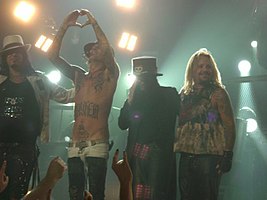Mötley Crüe - Simple English Wikipedia, the free encyclopedia
Mötley Crüe | |
|---|---|
 | |
| Background information | |
| Origin | Los Angeles, California, U.S. |
| Genres | |
| Years active | 1981–present |
| Labels | Mötley, Eleven Seven Music, Elektra, Leathür, Warner Music Group |
| Members | Nikki Sixx Mick Mars Tommy Lee Vince Neil |
| Past member(s) | John Corabi Randy Castillo Greg Leon |
| Website | www |
Mötley Crüe is an American rock band formed in 1981 based out of Los Angeles, California. They were one of the biggest glam metal bands of the 1980s. What was planned to be their final show took place at the Staples Center in Los Angeles on December 31, 2015.[4][5] Yet reunited in 2018 and have been touring active since.
History
[change | change source]Mötley Crüe was formed at the start of 1981. At first the band consisted of vocalist-guitarist Greg Leon, bassist Nikki Sixx, and drummer Tommy Lee. After auditions they found singer Vince Neil at a party and guitar player Mick Mars through an ad in a paper. They released their first album, Too Fast For Love, in 1981. The band later got signed to a major label. They built success over the next few years with their next three albums, Shout at the Devil, Theatre of Pain and Girls, Girls, Girls. Hit songs like "Shout at the Devil" "Home Sweet Home" and "Girls, Girls, Girls" came off these albums. However, the band created some negative attention because of their use of illegal drugs, large amounts of sex with women, and how they looked, such as wearing make-up and several tattoos. Nikki Sixx overdosed on heroin in 1987 and was legally dead for two minutes before getting an adrenaline shot. This made him conscious again. The band stopped using drugs and drinking shortly after. They released their most popular album, Dr. Feelgood, in 1989.
They released a greatest hits album in 1991 so fans had something to listen to before they brought out a sixth album. However, the band started arguing. Vince Neil left the band in 1992 because of this. So, the band found a new singer named John Corabi, who also played guitar and wrote lyrics. They released their self-titled album in 1994. It created a mixed response from fans who preferred Vince Neil as the band's singer, and did not like the music itself. It was more in-line with hard rock and alternative metal than the band's iconic glam metal sound. John Corabi left in 1996 and Vince Neil came back. The band released Generation Swine in 1997, but the album created a mixed response due to the musical experimentation.
Tommy Lee was unhappy with Vince Neil back in the band and further arguments between band members caused Lee to leave the band. He was replaced by Randy Castillo. The band released their least successful album, New Tattoo, in 2000. It sounded more like the band's 80s albums rather than the more alternative albums they released in the 90s. After the album, Randy Castillo became ill and Samantha Maloney had to drum during some of the band's concerts. Randy Castillo died in 2002, and the band did not do much for the next two years.
Mötley Crüe made a comeback with Tommy Lee in 2004, and were once again successful. The band toured worldwide and released another greatest hits album called Red, White and Crüe. They also released an album of new songs in 2008 called Saints of Los Angeles. The band disbanded after their planned last concert on December 31, 2015.[4][5] However, they got back together in 2018.
Albums
[change | change source]- Too Fast for Love (1981)
- Shout at the Devil (1983)
- Theatre of Pain (1985)
- Girls, Girls, Girls (1987)
- Dr.Feelgood (1989)
- Mötley Crüe (1994)
- Generation Swine (1997)
- New Tattoo (2000)
- Saints of Los Angeles (2008)
References
[change | change source]- ↑ McPadden, Mike (25 September 2015). "The Hair Metal 100: Ranking the '80s Greatest Glam Bands—The Final 20!". VH1. Archived from the original on June 29, 2022. Retrieved 16 July 2016.
- ↑ Hart, Josh (December 2, 2011). "Motley Crue to Become First Hard Rock Band to Hold Las Vegas Residency". Guitar World. Archived from the original on April 14, 2021. Retrieved February 20, 2021.
- ↑ Rivadavia, Eduardo (September 26, 2015). "How Motley Crue Staked Their Claim With 'Shout at the Devil'". Ultimate Classic Rock. Archived from the original on March 28, 2020. Retrieved October 5, 2021.
- ↑ 4.0 4.1 "Mötley Crüe's Final Tour". Motley.com. Retrieved October 7, 2014.
- ↑ 5.0 5.1 "Nikki Sixx Officially Announces The End Of Motley Crue". Ultimate Guitar.


 French
French Deutsch
Deutsch